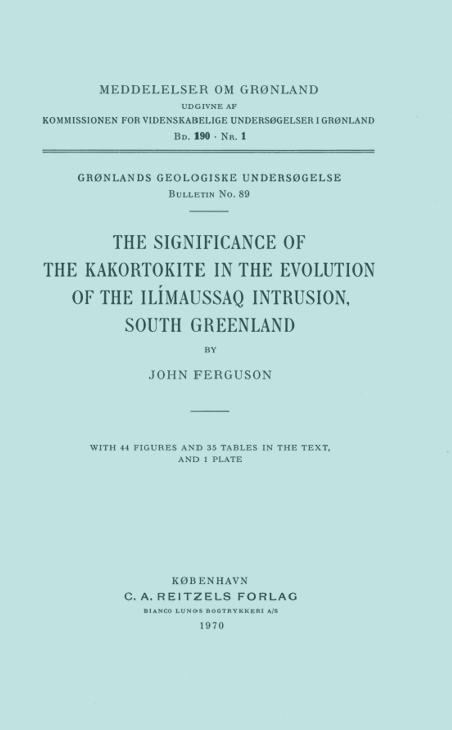The significance of the kakortokite in the Evolution of the Ilímaussaq Intrusion, South Greenland.
DOI:
https://doi.org/10.7146/mog.v190.150327Abstract
The feldspars of the intrusive rocks of Ilimaussaq were subjected to a fairly detailed mineralogical investigation. The K-feldspars from the early augite syenite have an average obliquity of 0.61 compared with the corresponding value of 0.90 for the feldspars of the remaining rock types. In addition, the obliquity values within the augite syenite group show a mildly contrasting variation related to the grainsize of the rock. The co-existing augites and olivines in the augite syenite vary sympathetically with the obliquity values. The structural states and compositions of the Na-feldspars in the major rock groups of the Intrusion indicate that they are all low temperature albites.
Most of the rock types in the Intrusion develop rhythmic layering. Petrofabric analyses of the kakortokite and lujavrites indicate that the cumulus minerals show a marked planarism and, in some cases, lineation. Six new major element rock analyses of kakortokite together with pre-existing published analyses have been presented in ternary diagrams. In addition, quantitative analyses were carried out on 90 whole rock specimens for the following elements: Na, K, Rb, Li, Cs, Ca, Sr, Ba, Ti, Zr, Nb, Sn, Be, La and Ga. Further results include semi-quantitative analyses for Bi, Pb, Zn, Sb, Sn, Y, Be; Mo, Nb, Cu, Ni, La, Ag, Co and V on 100 kakortokite rocks and 40 minerals. The fractionation trend displayed by the K: Rb ratio shows a remarkably strong correlation with the chronology as determined from the field evidence. Other ratios used include Sr:Ca, Ba:Rb, Ti:Zr, Ti:Nb and Zr:Nb. In general these ratios conform to established behaviour patterns during fractionation; an exception is the Zr: Nb ratio which increases with fractionation. Furthermore, the kakortokite sequence displays a generally progressive variation of these ratios with height, suggesting that they crystallized from the floor upwards.
On the basis of field evidence, petrology and geochemistry it would appear that the earliest magma of the Intrusion had an augite syenitic composition. It is thought that this original augite syenitic magma differentiated along an undersaturated trend and that the heterogeneous syenite represents the roof-development of the innermost differentiate of the augite syenite. It is postulated that by the addition of volatiles the inner augite syenitic magma was converted to a magma of peralkaline composition. The agpaitic (per-alkaline) magma then underwent crystallization which took place from the roof downwards with simultaneous gravity accumulation of the heavier minerals on the floor of the Intrusion. This gave rise to both the sheeted occurrences of sodalite foyaite and naujaite, essentially products of the flotation of sodalite and intercumulus crystallization, and the markedly rhythmically layered kakortokite, a product of gravity accumulation. Finally, a residual liquid, rich in volatiles, was trapped between the downward crystallizing naujaite and the gravity accumulated kakortokite. As a result of faulting and/or slumping the residual mush was injected into the overlying brecciated rocks where it crystallized to form the fissile lujavrites. The origin of the alkali granite is problematical but it would appear to predate the agpaites and post-date the augite sycnite and heterogeneous syenite.

Downloads
Published
How to Cite
Issue
Section
License
Coypyright by the authors and the Commision for Scientific Research in Greenland. No parts of the publications may be reproduced in any form without the written permission by the copyright owners.

